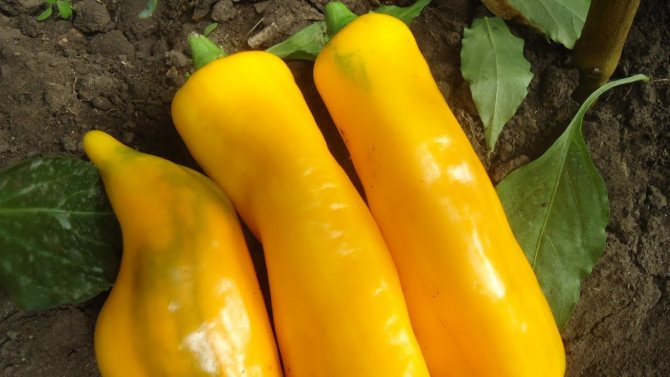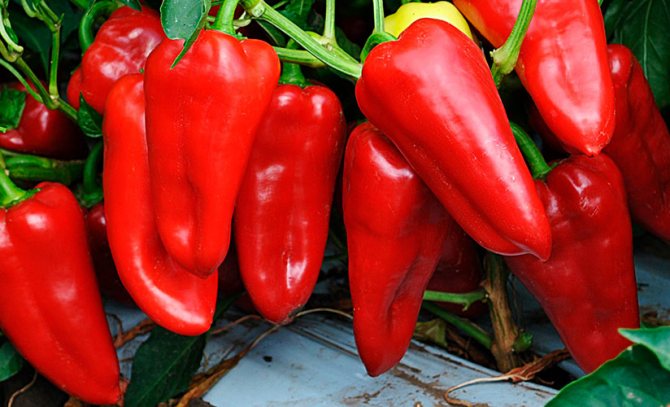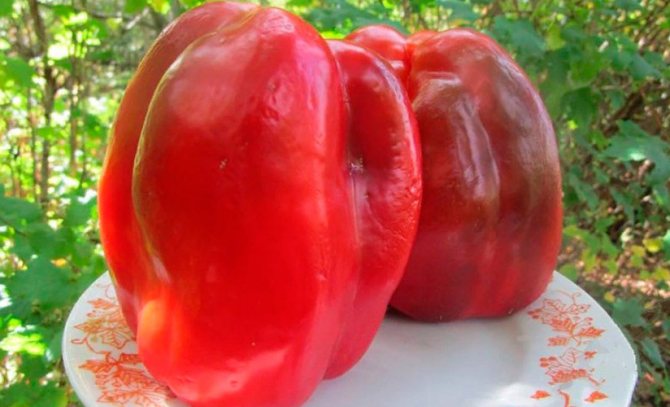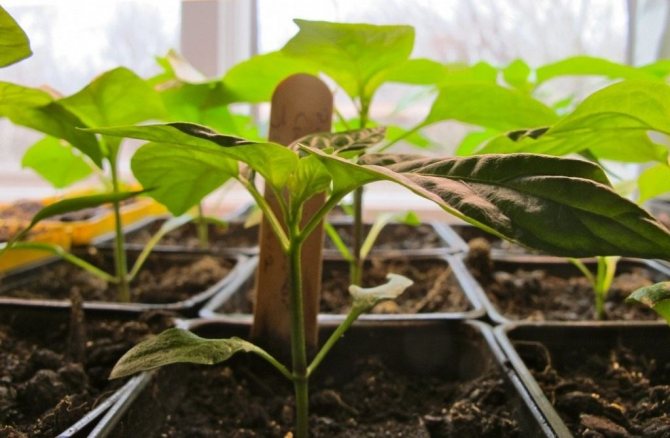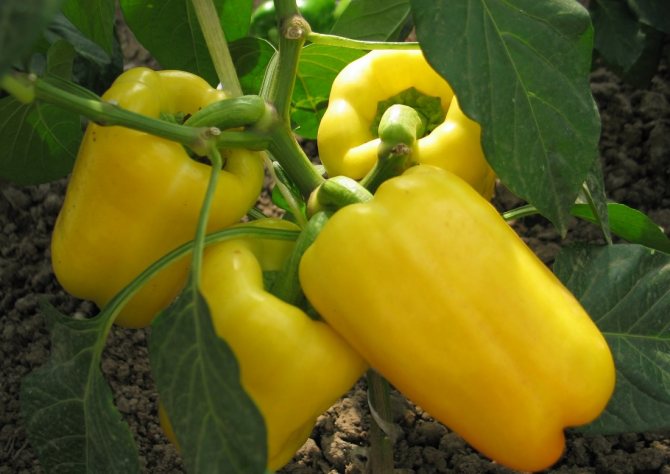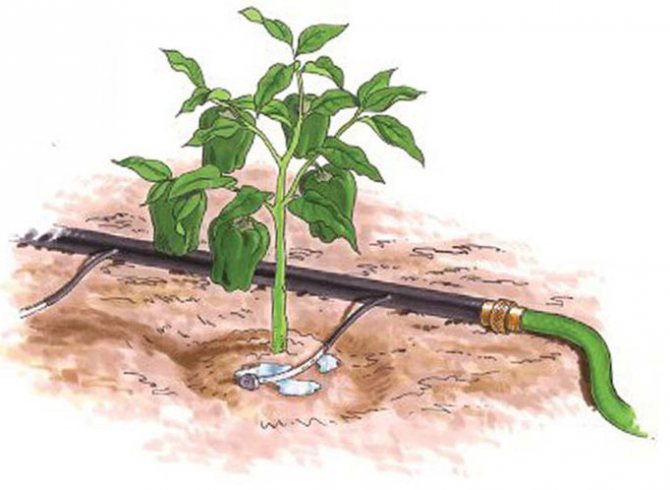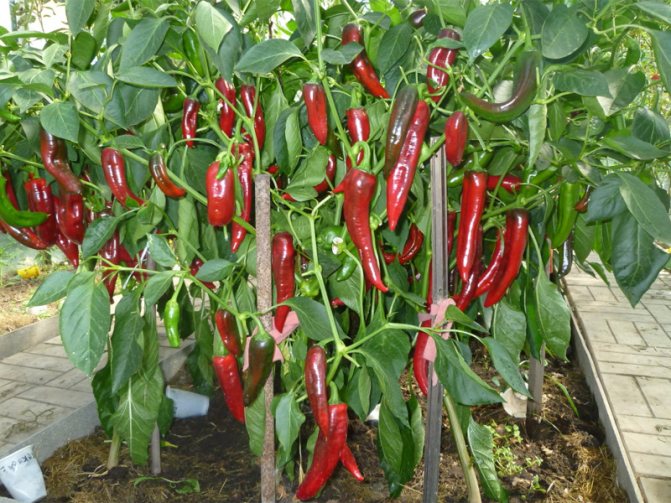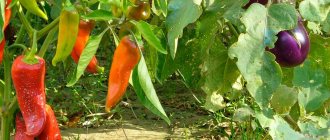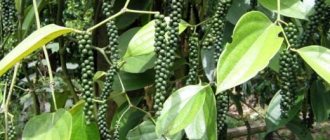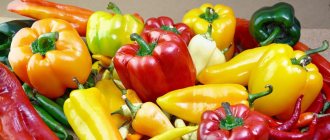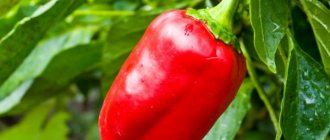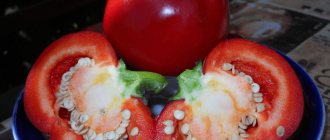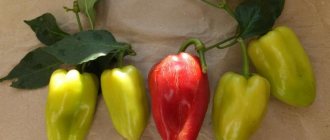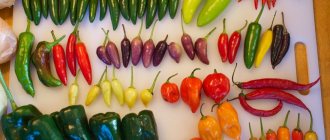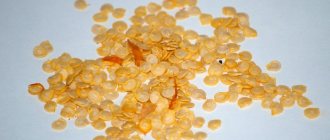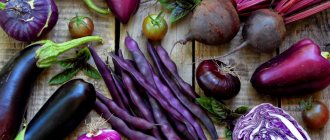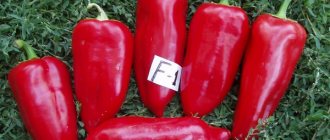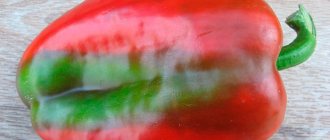It is no secret that we can get the most accurate information about varieties and hybrids of vegetables, and peppers are no exception, after varietal testing at the selection stations of the country that exist in every region.
After a successful variety test, the registration commission enters the variety into the register of breeding achievements, or does not enter it. She recommends growing in a specific region with specific guidelines.
Pepper variety "Cardinal" is not entered in the register. Perhaps he is still under strain testing and will soon replenish breeding novelties, and perhaps this will never happen.
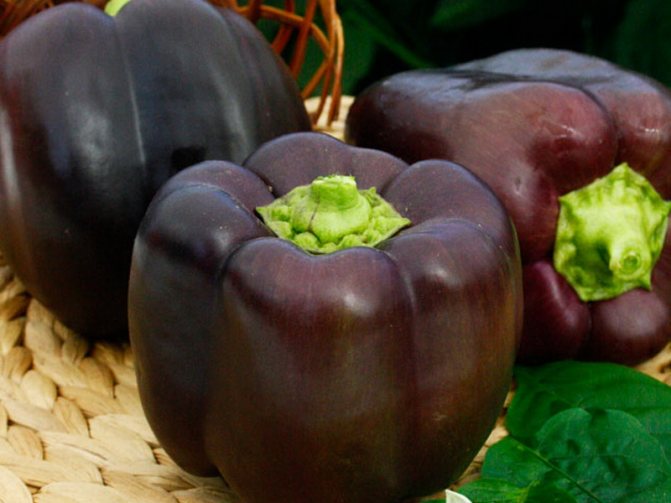
However, it so happened that the market was flooded with all sorts of "cardinals" and they need to be sorted out.
Characteristics of the variety
Cardinal is an early maturing variety. The culture reaches a height of 100 cm. Technical ripeness occurs in 90 days.
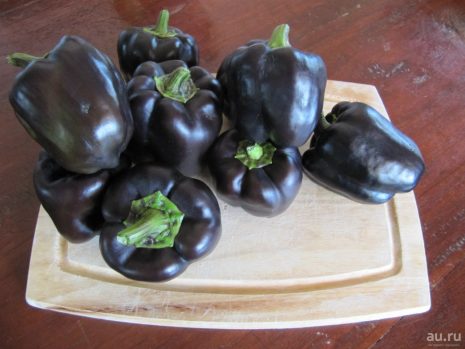

The fruits are large, cuboid. Their weight does not exceed 250 grams. The pepper is represented by a purple color. Subject to the cultivation technology, the yield is up to 14 kg per 1 sq. m.
Advantages and weaknesses
The demand for the Cardinal is due to the presence of a number of advantages. He possesses:
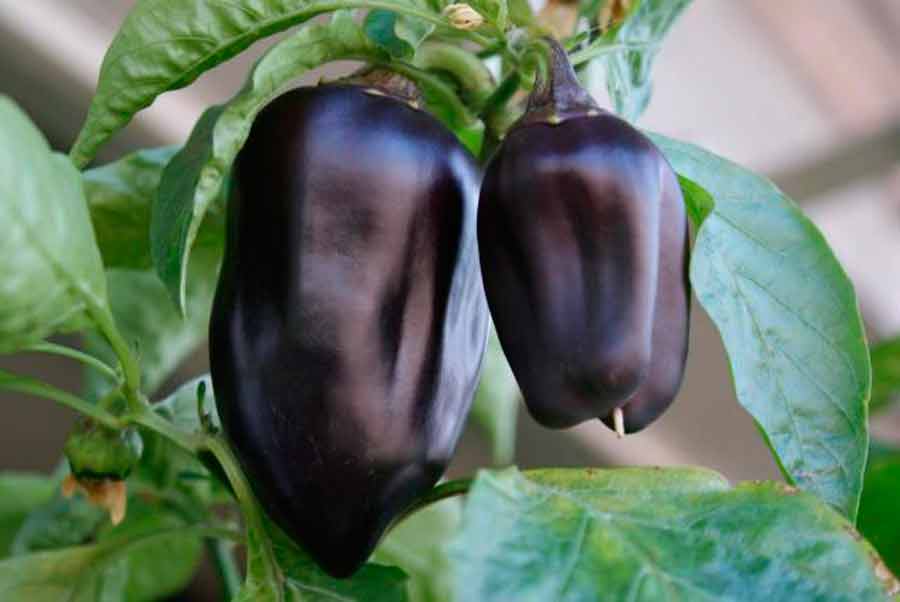

- high yields;
- excellent taste;
- resistant to many diseases.
It should be noted that the Cardinal is suitable for consumption both fresh and canned.
Darkening of a vegetable during canning is considered its main disadvantage.
Agrotechnics of growing pepper
For planting pepper, the seedling method is used. Since the growing season for a crop is 200 days, it is necessary to start sowing seeds already at the end of February.
First you need to prepare the boxes, fill them with soil. It is best to purchase ready-made formulations. The seeding depth of seeds is no more than 2 cm. In order for the seeds to germinate, it is required to withstand the crops at temperatures up to 28 degrees. As soon as the first shoots appear, the temperature regime must be reduced to 20 degrees.
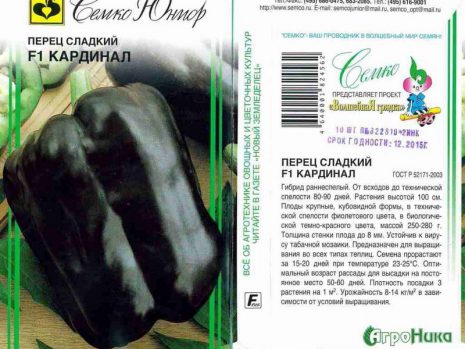

Plants need good lighting. Daylight hours should be long, at least 14 hours. If necessary, you can use additional light sources.
20 days after sowing the seeds, a pick should be done. To do this, you need to plant the plants in separate pots. In this case, weakened specimens should be excluded immediately.
Note. Mineral fertilizers do not need to be added to the soil.
Iconography
Cardinal is a medium-sized, early ripening pepper hybrid that is ideal for growing on farms. Cardinal pepper is especially popular because of its beautiful fruits. The leaves of the plant are small, dark green in color. The pimento is fleshy. With proper care and favorable conditions, it grows up to 130 g. Rastenjice prefers well-lit places. This hybrid is renowned for its high palatability. In addition to the pluses, the speed of fruit ripening can be attributed.
Pepper precursors
In order for the culture to take root well on the site, it is necessary to carefully consider the choice of the garden. To do this, you need to pay attention to the rotation of crops in the crop rotation system.
The best precursors for pepper are the following crops: cucumbers, onions, cabbage, pumpkin, squash, carrots.
You may be interested in: Favorable days for picking peppers in 2020 according to the lunar calendar Favorable days for sowing sweet and hot peppers for seedlings in 2020 Is it possible to spill peppers and how to do it correctly
Important. It is not recommended to plant peppers after eggplant, potatoes, peppers, tomatoes.
Gardeners reviews
On various forums dedicated to the cultivation of crops, there are often positive reviews about the Cardinal. Many people note the pleasant taste of the vegetable. Housewives are happy to add pepper to salads or bake it whole in the oven.
The variety attracts with voluminous fruits and a thick wall. Gardeners also pay attention to fast crop growth and excellent yields.
Cardinal is a rather unpretentious variety. However, in order to obtain the desired results, the plant should be properly looked after, not ignoring the advice of professionals.
Planting pepper in open ground
For growing crops, it is best to pick up light soils. 5 days before planting seedlings in the garden, it is necessary to decontaminate the land. To do this, add 20 grams of copper sulfate to a bucket of water and treat the soil with the composition. Planting work can be started at the end of May.
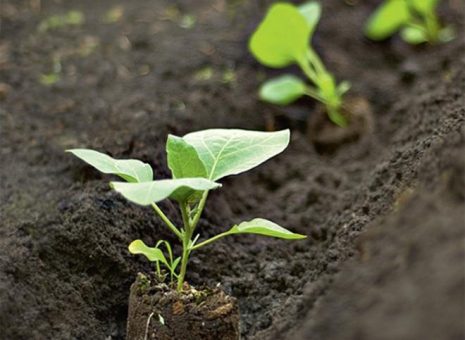

The garden needs to be dug up, fertilized, carefully removed from the pots. It is necessary to plant plants in the hole at the same depth at which they were in the boxes.
Advantages and disadvantages
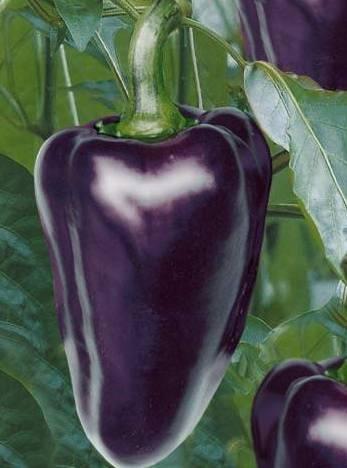

Cardinal peppers, although they messed up with them pretty much, have a number of their advantages:
- exotic color;
- thick wall;
- disease resistance;
- good yield.
The disadvantage can be considered a misclassification and sheer confusion, which simply misleads people. In addition, the fact that the varieties lose their purple color is very saddening for those vegetable growers who counted on constant exoticism.
These peppers have one more significant drawback, which will be discussed in the section on the purpose of the variety.
Pepper care
To get a good harvest, you need to make every effort. Pepper care includes important procedures.
- Temperature conditions. Plants for normal development need to provide a temperature regime within 20-25 degrees. If the indicators are below 13 degrees Celsius, crops must be covered without fail.
- Watering. Peppers need abundant watering. For the procedure, you must use warm water, rain or settled. Even before flowering, watering can be done once a week. In the heat, the number of waterings can be doubled. During flowering and during fruiting, you can water the plants 3 times a week.
- Top dressing. During flowering, plants need fertilization. In their capacity, you can use the following composition: leaves of nettle, woodlice, dandelion, plantain, coltsfoot, 10 liters of rotted manure, 200 grams of ash.
Important. During fruiting, poultry manure and cow dung should be used as fertilizers. - Loosening and weeding. Plants prefer to grow on loose soil, have a negative attitude towards weeds. Therefore, weeding should be carried out in a timely manner.
- Mulching. If you mulch the soil, it will be possible to protect the soil from drying out and the appearance of weeds.
- Tying. The event is required. This is due to the fact that the plants are tall and can break under the weight of the fruit.
- Draft protection. To protect the crops from the wind, tall plants must be planted around the pepper.
- Pollination. To get a good harvest, it is necessary to carry out pollination. The culture is self-pollinating. However, experienced gardeners recommend additional pollination.
Fact. If the plants do not receive proper pollination, the fruit will be deformed.
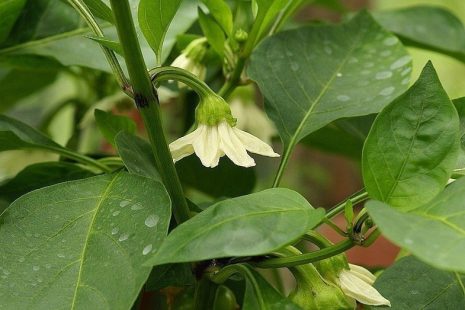

Soil preparation
Most of all, burn weeds, dried remains of garden crops, branches, straw, etc.and kick it around the garden with a layer of 6-8 cm, and then dig it up along with the fertilizers. Do c) to this degree for 2-3 years in a row - and work in the garden will be much easier.
As it is possible to scatter coarse sand with a layer of 2-3 cm around the garden and dig it along with fertilizers. Crushed brick is a good remedy. It is sifted through a large sieve due to the fault and the soil is covered with a layer of 2-4 cm, and then dug up.
Nurturing seedlings
For growing peppers, it is recommended to use the seedling method. Execution) of this in February, the seeds are sown in a box, provide the appropriate temperature (little: illiterate below 23 degrees) until shoots appear, and then keep them in a well-lit place and additionally light up 3-4 hours in the morning and in the evening.
- Seeds are sown in individual containers. When the seedlings grow 3-4 true leaves, it only remains to plant them (cut them open) in pots or boxes, but less often - at a distance of 5-7 cm.
- So that the vegetable begins to sprout faster, the crops are covered with glass. They do not allow the appearance of condensation, for no reason as waterlogging can lead to soil rotting.
- With the onset of constant warm days, at least move the seedlings to sunny greenhouses or film shelters on arcs. Get a permanent place to plant no earlier than the last days of May.
- Seedlings need watering, feeding, loosening the soil. The male sexual organ is very fond of warmth, humidity and calm weather.
- When growing pepper seedlings in a greenhouse, plants are simply watered at the root.
Providing watering
Watering is carried out with heated water. The simplest "solar plant" is just right to make from a black rubber hose. By the way, it is better to water it with general rainwater, which helps to increase the yield.
What do you need to get rid of slugs and snails?
We just have to take a head of garlic, knead it and then make an infusion. We make the infusion somewhere in a liter of water. Then we take 100-150 grams of solution. After a three-day infusion, we dilute up to 10 liters of water and spray our plants from all sides. It is completely harmless for plants, but slugs will not come to us, they will not eat our fruits.
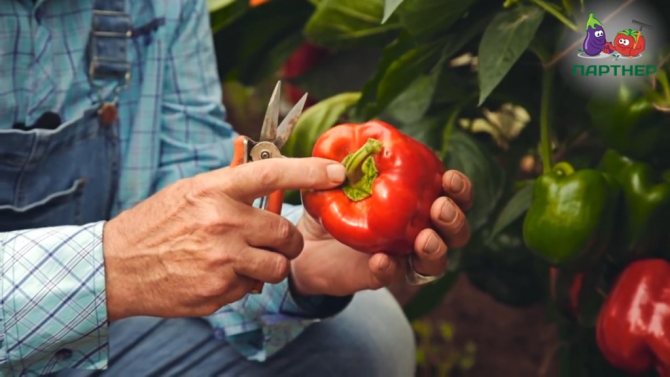

As a rule, when biological ripeness comes, they settle here, even overwinter in this depression and continue eating, even getting inside the pepper. Therefore, the easiest way is garlic. You can use this solution for a long time, which you will make from one head of garlic.
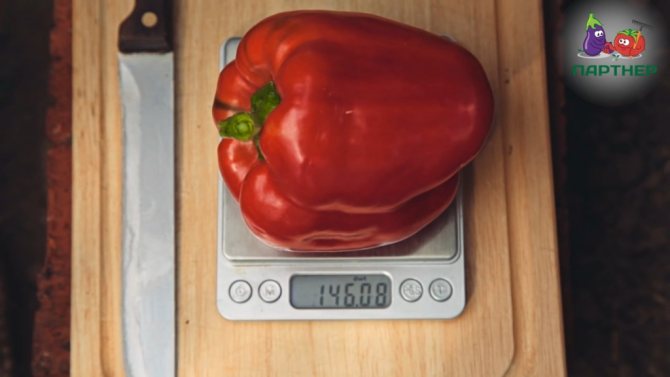

Now, as always, we must weigh this fruit. We weigh the fruit. In general, practically in technical ripeness, it already weighs 146 grams. But, it is clear that when it becomes even more poured, ripens, it will reach 200 grams, the pulp will thicken.
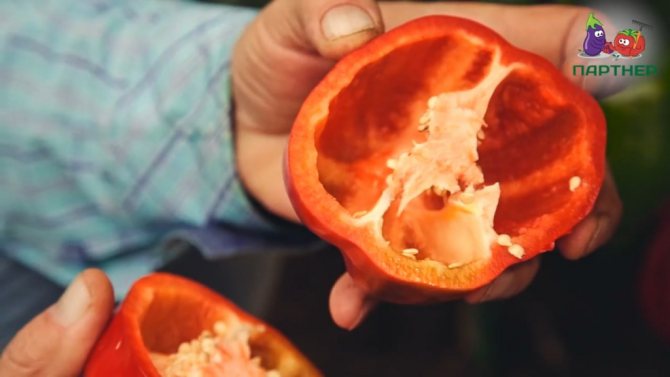

And now we will check how thick the flesh of the pepper is. We will cut, as always, across and we will see. Nice pepper. You can see that the pulp has not yet reached its final thickness. Somewhere 7 mm in thickness. I am sure that 2 millimeters will be added.
I hope that you also liked this pepper very, very much. The yield is very good, about 10 kg on average per square meter, that is, from 3 plants. So plant this pepper and enjoy the flavor.
And now, as always, we will also try. Juicy, sugary sweet. It will still ripen, it is still in technical ripeness, the pepper has not yet acquired its full color, has not fully poured. I think you will also like it very much, and you will grow this wonderful hybrid on your plots.
Description and properties of bell pepper
Bell peppers are known in Russia under many names, among which the most common are: bell peppers, vegetable peppers, paprika, and even red or green peppers.
The appearance of the plant is known to everyone, even people far from gardening.From the point of view of botany, bell peppers are an annual garden vegetable crop with a relatively low bush, usually up to 1.5 meters, single or group leaves in the form of rosettes, colored green and its various shades of color. The plant has relatively large flowers, the fruits are hollow false berries of various sizes and colors. The peppercorns can be red, yellow, orange, green, or brown.
Pepper, in addition to its excellent taste, has a number of useful properties. It has a healing and preventive effect, significantly reduces the risk of many serious diseases, stimulates appetite and activates the digestive system. It is possible to enumerate the beneficial properties of sweet peppers for a long time, especially since their number, thanks to the constant research of scientists, is increasing all the time.
Selection criteria for bell pepper seeds
Currently, any specialty store contains just a huge selection of sweet pepper seeds for planting. To navigate this diversity, it is necessary to clearly understand the criteria by which to make a choice.
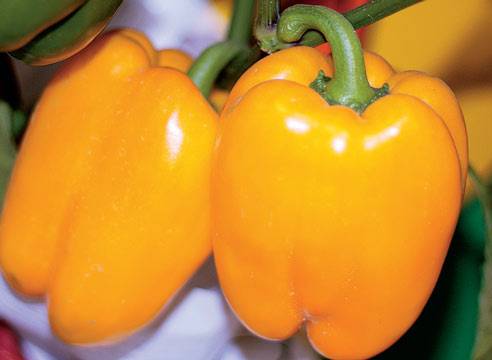

First of all, it is necessary to carefully study the properties and characteristics of the proposed variety, the description of which is always placed on a bag with seeds.
The main attention should be paid to the following properties:
Grade ripening term. According to this criterion, all plants are divided into:
- early maturing varieties and hybrids. They are better suited for planting in unprotected soil, as they manage to mature even in suboptimal conditions of a short period of steadily warm and sunny weather. It is these conditions that are most typical for the domestic middle zone;
- mid-season varieties and hybrids. They can be used both in greenhouses and in unprotected ground. In the second case, they will require a little more attention and care necessary to ensure a good and stable harvest;
- late-ripening varieties and hybrids. They are most adapted for the conditions of greenhouses, since in the open ground, in most cases, they simply do not have time to mature to the required stage.
The resistance of the sweet pepper variety to diseases and pests common in a particular region.
Zoning of a variety or hybrid for a specific region where it is planned to grow.
One of the important criteria for the selection of sweet pepper seeds is the establishment of priority between varieties and hybrids.
The main advantage of the variety is the ability to independently harvest seeds for future planting. In addition, varietal varieties, as a rule, are less whimsical and more resistant, if we take the totality of their properties and characteristics.
It makes no sense to harvest the seeds of hybrids, since their properties are not preserved for the next harvest. However, hybrids have their own advantages: higher yield and excellent taste.
Following these criteria will help the grower make the right variety or hybrid selection when purchasing sweet pepper seeds.
Greenhouse Pepper Varieties Comparison Table
| Features of the | Variety | Weight, g | Ripening period, days |
| Harvest | Gourmet | 200 | 130 |
| Gemeni f1 | 300 | 75 | |
| Agapovsky | 120 | 120 | |
| Atlant | 190 | 120 | |
| Apricot Favorite | 300 | 100–115 | |
| Belladonna f1 | 200 | 110 | |
| Tall | Orange miracle | 300 | 100 |
| Claudio f1 | 270 | 70–75 | |
| California miracle | 130 | 100–120 | |
| Isabella f1 | 160 | 115–125 | |
| Early | Pride of Russia | 130 | 100–105 |
| Cardinal f1 | 280 | 80–90 | |
| Indalo f1 | 280 | 110–115 | |
| Bagration | 200 | 100–105 | |
| For the middle lane | Bandai | 400 | 110–120 |
| Father | 150 | 85–95 | |
| Tenderness | 100 | 110–120 | |
| Smooth Kambi | 150 | 100 | |
| Snowball | 150 | 95–105 | |
| For Siberia | Triton | 200 | 76 |
| Firstborn of Siberia | 75 | 125–130 | |
| Novosibirsk | 120 | 100 | |
| For gardeners of the Moscow region | Pinocchio f1 | 120 | 90 |
| Winnie the Pooh | 60–70 | 110 | |
| Mercury | 110–120 | 90–100 | |
| For the Urals | Amber | 150 | 115 |
| Gingerbread man | 140 | 100–110 | |
| Knight f1 | 200 | 110–118 |
How to increase yields?
Subject to the sowing dates, agrotechnical techniques and crop rotation rules, the variety gives high yield results.Outdoor yields are usually higher than under greenhouse conditions, but not all regions can be grown outside the greenhouse.
It is possible to increase the yield by using complexes of mineral and organic fertilizers, controlling the amount of ovary. Also, an increase in yield can be achieved by removing the fruits during the period of technical maturity and leaving them to ripen separately, then the plants will begin to form a new ovary, the fruiting period will increase and, accordingly, the yield will increase.
Features of agricultural technology of a tall plant
Peppers must be grown using a seedling technique. The effectiveness of the gardener's work when planting a crop determines the observance of several basic requirements:
- seeds are germinated at a temperature of 23 - 25 degrees;
- the seedlings move to the garden bed after reaching the age of 50 - 60 days;
- up to 3 crops are planted per 1 m2;
- pepper is watered with a drip method;
- the first feeding is carried out 10 days after planting in the greenhouse;
- bushes are tied to trellises;
- on plants, all branches are removed to the main fork, then 2 - 3 trunks are formed.
Sowing seeds for seedlings
Planting seedlings in a greenhouse / greenhouse
Planting seedlings in OG
Stepping
Harvesting
How to store a vegetable in winter?
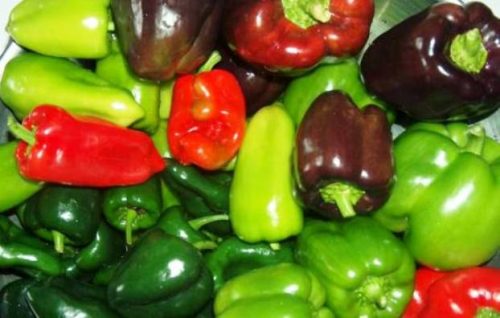

There are several ways to use the crop: fresh consumption, conservation, drying, freezing. Let's talk a little about some of them.
Keeping fresh
Bell peppers must be technically ripe. It is recommended that the following conditions be met:
- put in a ventilated plastic bag and then in boxes;
- take out the fruits in a ventilated place;
- maintain the temperature from 0 to +2, room temperature is allowed - +20, but with shorter shelf life;
- do not put in the refrigerator;
- keep humidity 85-90%.
The peppers do not have to be plucked; they can be stored with the torn bush.
Freezing
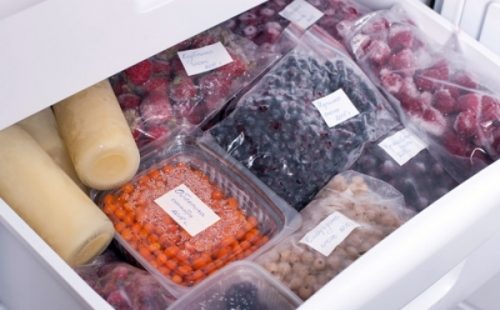

The fruits of the Cardinal pepper can be in the freezer all winter, almost without changing the taste. There are 2 options for such storage while maintaining the required level of vitamins:
- in the form of pieces (from which soups and stews are prepared);
- whole, for stuffing
The largest, biologically ripe fruits - fully ripe and with a characteristic color - are frozen.
Drying
Before this procedure, the peppers are thoroughly washed and freed from seeds. Then the vegetable is cut into neat slices. You can dry it with:
- a special electrical appliance at a temperature of +50 degrees;
- oven, gas or electric;
- microwave ovens;
- sun rays at + 30 throughout the week.
During the drying process, you must watch the peppers, stirring them thoroughly. The finished slices must be allowed to cool completely.
The most popular way of storing bell peppers is conservation. Due to the pleasant taste of the fruits, they make delicious assorted vegetables.
Summer residents themselves can tell in more detail about the benefits of the variety.
Diseases
Sometimes, pale gray spots can be observed on the tops of the fruits, which then turn black. This is a physiological disease of pepper caused by unfavorable conditions for the development of plants. It is necessary to regularly water the plants, make sure that the soil layer is moistened at a distance of 50 cm from the surface.
Peppers need to be grown so that they return to the same place no earlier than 5 years later. As diseased plants appear, as well as after harvesting, it is necessary to collect plant residues, take them outside the gardens and burn them.
Plants should not be planted close to each other, with this arrangement, the likelihood of infection with mucous rot increases.
With proper care and favorable weather conditions, the fruits grow up to 130 g. This hybrid has a high taste. Also, the advantages include the ripening speed and good transportability of the fruits.
Diseases and harmful insects
The Cardinal variety is exposed to the same hazards as other types of bell peppers.If in a tropical climate the culture is not afraid of anything, the middle lane does not provide it with such favorable conditions. There are several infections and fungi that can deprive summer residents of the entire crop:
Blackleg. It affects both seedlings and adult plants. It appears as a dark spot on the root neck. The causative agent of the disease develops at high humidity. It remains in the soil, so it is not recommended to plant peppers after nightshades. In case of untimely treatment, the culture withers, and the fungus spreads along the roots. The contaminated soil must be disinfected, and diseased seedlings must be urgently removed. Preventive measures are as follows:
- airing the greenhouse;
- maintaining normal temperature;
- elimination of stagnant water.
Mosaic. It is a virus that leads to the formation of colored spots on the leaves. This variety is resistant to this disease, but only with full adherence to agricultural technology and prevention.
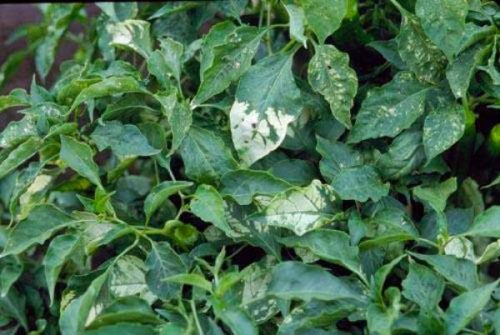

Every year, 20% of the bell pepper harvest dies from ailment. The virus also infects the roots of the plant, but it is impossible to determine this without special instruments.
The crop is infected through seeds or soil, and then the disease spreads rapidly throughout the plantation. To combat it, you need to disinfect the soil and treat the seeds with special solutions.
Black spot. Bacterial pathology. It occurs on all parts of the plant, including fruits. Young peppers die from it, and adults give a poor-quality crop.
Signs:
- small, gradually growing dots on the stem and leaves;
- large dark spots bordered in yellow;
- bumps on fruits that turn into ulcers.
To avoid defeat, do not forget:
- carefully weed the soil from weeds;
- to pickle planting material;
- plant only healthy seeds.
Another problem for gardeners is pests. They feed on roots, leaves, fruits and stems of crops. Sweet peppers can be threatened by:
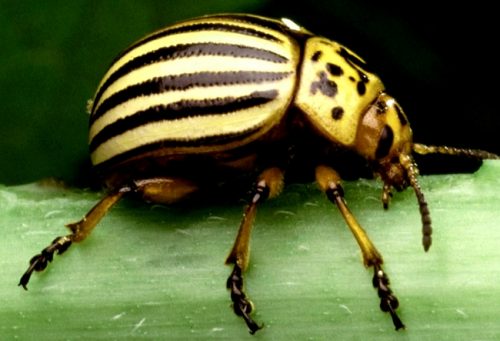

Colorado beetle. To protect the pepper, it is enough to plant a nightshade plant, for example, potatoes or eggplants, on the site, then the parasite will prefer this culture. If the pest is still wound up, you will have to collect it manually. The beetle can be found on all parts of the plant: stem, leaves, flowers. The insect sucks out all the juices from the pepper, so the leaves dry out and the fruits become ugly. Parasites multiply at a temperature of + 25 and high humidity.
Spider mite. It can settle on the inside of the leaf. The insect envelops the plant with a thin film. The first signs of the disease may go unnoticed, and then "marble dots" appear on the leaves. This is how the larvae eating the tissue of the culture look. As a result:
- the color of greenery changes;
- leaves fall and wither;
- fruits are affected.
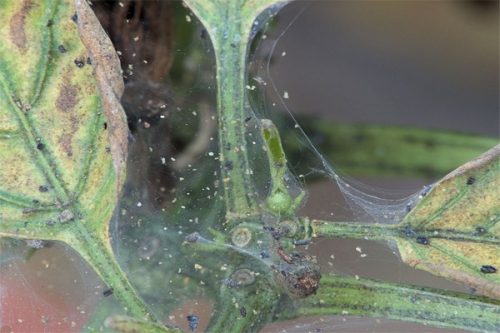

In order to avoid the appearance of the parasite, it is advised to treat the upper part of the soil with a solution of bleach. On industrial plantations, the phytoseilus beetle is used to eat the tick.
Slugs. They feed on plant roots, seedlings, fruits, leaves. The insect gnaws large ugly holes in the vegetable. Its activity manifests itself in the evening or at night, in the absence of light and danger. It is not recommended to flood the plant, as this leads to the appearance of a pest. It is also advisable to remove weeds, as the parasites like to settle in silage accumulations. To combat them, you need to sprinkle the soil with tobacco dust, lime.
To protect your crop from destruction, you need to properly care for vegetables and use chemicals.
Dutch Peppers - Premium Quality!
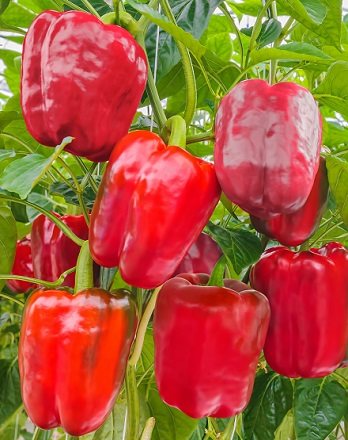

Ask an experienced gardener: “What is the secret of a rich, serious pepper crop? Where to begin?" And you will certainly hear in response: “Start with seeds. With the right choice of variety, or better - a hybrid. " And it is true: a hybrid obtained from crossing two different peppers surpasses the "parents" in vitality, yield, and taste. Law of nature!
Dutch and Japanese scientists-breeders conjured over the hybrids of Gemini and Ombrone peppers, exactly those that were bred by the already well-known superpeppers Tevere and Red Knight and the peppers were a success. Gemini pepper will provide you with an early harvest, from planting seedlings to fruiting, it takes less than 70 days. And an incredible abundance awaits you: 10 or even 15 bright yellow "handsome men" weighing up to 400 grams, the size of a liter jar, ripen on a powerful bush at the same time! One such pepper is enough for a salad for the whole family. More than a bucket of pepper from one bush, this is a guaranteed yield with minimal maintenance! The Gemini fruit is perfectly cubic in shape and has a juicy pulp and an amazingly sweet taste. The hardy and strong Gemini pepper is not afraid of either disease or the whims of our Ural nature.
Pepper Ombrone, competitor and “brother” of Gemini, is also among the leaders of the world selection. Spectacular glossy, dense red fruits of Ombrone will tempt you with their beauty in the garden, namely with a red wall of phenomenal harvest. One bush of Ombrone pepper yields as 3-4 bushes of common varieties of peppers, fruits of the correct shape, which are ideal for our favorite treat stuffed pepper! When the Ombrone peppers are ripe, you will truly enjoy the balanced, perky sweet taste! And what is certainly important for us Urals, Ombrone will not be scared by the cold: the hybrid perfectly sets fruit even at low temperatures. Note that no GMO techniques were used to create these great peppers.

